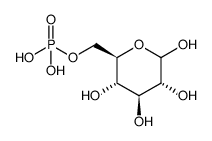6-Phosphogluconic acid

6-Phosphogluconic acid structure
|
Common Name | 6-Phosphogluconic acid | ||
|---|---|---|---|---|
| CAS Number | 921-62-0 | Molecular Weight | 276.135 | |
| Density | 2.0±0.1 g/cm3 | Boiling Point | 774.8±70.0 °C at 760 mmHg | |
| Molecular Formula | C6H13O10P | Melting Point | N/A | |
| MSDS | Chinese USA | Flash Point | 422.4±35.7 °C | |
| Symbol |

GHS07 |
Signal Word | Warning | |
Use of 6-Phosphogluconic acid6-Phosphogluconic acid is a potent and competitive phosphoglucose isomerase (PGI) inhibitor with Kis of 48 μM for glucose 6-phosphate and 42 μM for fructose 6-phosphate. 6-Phosphogluconic acid is an endogenous metabolite[1][2]. |
| Name | 6-phospho-D-gluconic acid |
|---|---|
| Synonym | More Synonyms |
| Description | 6-Phosphogluconic acid is a potent and competitive phosphoglucose isomerase (PGI) inhibitor with Kis of 48 μM for glucose 6-phosphate and 42 μM for fructose 6-phosphate. 6-Phosphogluconic acid is an endogenous metabolite[1][2]. |
|---|---|
| Related Catalog | |
| Target |
Human Endogenous Metabolite |
| In Vitro | 6-Phosphogluconic acid (0.5-2.0 mM) completely inhibits the activity of PGI with glucose 6-phosphate (0.05- 0.5 mM) as the substrate[1]. |
| References |
| Density | 2.0±0.1 g/cm3 |
|---|---|
| Boiling Point | 774.8±70.0 °C at 760 mmHg |
| Molecular Formula | C6H13O10P |
| Molecular Weight | 276.135 |
| Flash Point | 422.4±35.7 °C |
| Exact Mass | 276.024628 |
| PSA | 406.56000 |
| LogP | -3.25 |
| Vapour Pressure | 0.0±6.0 mmHg at 25°C |
| Index of Refraction | 1.623 |
| Storage condition | 20°C |
| Symbol |

GHS07 |
|---|---|
| Signal Word | Warning |
| Hazard Statements | H302 + H332 |
| Precautionary Statements | P261-P301 + P312 + P330-P304 + P340 + P312 |
| Personal Protective Equipment | dust mask type N95 (US);Eyeshields;Gloves |
| Hazard Codes | Xn: Harmful; |
| Risk Phrases | R20/22 |
| Safety Phrases | 28 |
| RIDADR | UN 1564 6.1/PG 3 |
| Packaging Group | III |
|
~% 
6-Phosphoglucon... CAS#:921-62-0 |
| Literature: Biochemical Journal, , vol. 25, p. 323,329 Biochemische Zeitschrift, , vol. 292, p. 289 |
|
~% 
6-Phosphoglucon... CAS#:921-62-0 |
| Literature: Indian Journal of Chemistry - Section A Inorganic, Physical, Theoretical and Analytical Chemistry, , vol. 35, # 5 p. 427 - 430 |
|
~% 
6-Phosphoglucon... CAS#:921-62-0 |
| Literature: Biochemical Journal, , vol. 25, p. 323,329 |
|
~% 
6-Phosphoglucon... CAS#:921-62-0 |
| Literature: Biochemical Journal, , vol. 25, p. 323,329 |
|
~% 
6-Phosphoglucon... CAS#:921-62-0 |
| Literature: Biochemical Journal, , vol. 25, p. 323,329 |
|
Inferring the metabolism of human orphan metabolites from their metabolic network context affirms human gluconokinase activity.
Biochem. J. 449(2) , 427-35, (2013) Metabolic network reconstructions define metabolic information within a target organism and can therefore be used to address incomplete metabolic information. In the present study we used a computatio... |
|
|
Phosphoglycerate mutase 1 coordinates glycolysis and biosynthesis to promote tumor growth.
Cancer Cell 22(5) , 585-600, (2012) It is unclear how cancer cells coordinate glycolysis and biosynthesis to support rapidly growing tumors. We found that the glycolytic enzyme phosphoglycerate mutase 1 (PGAM1), commonly upregulated in ... |
|
|
A novel NADPH:(bound) NADP+ reductase and NADH:(bound) NADP+ transhydrogenase function in bovine liver catalase.
Biochem. J. 385(Pt 3) , 763-8, (2005) Many catalases have the shared property of containing bound NADPH and being susceptible to inactivation by their own substrate, H2O2. The presence of additional (unbound) NADPH effectively prevents bo... |
| 6-PHOSPHOGLUCONIC ACID BARIUM SALT |
| EINECS 213-069-9 |
| 6-Phosphogluconate Barium Salt Hydrate |
| MFCD00066440 |
| 6-O-Phosphonohexonic acid |
| Hexonic acid, 6-(dihydrogen phosphate) |




